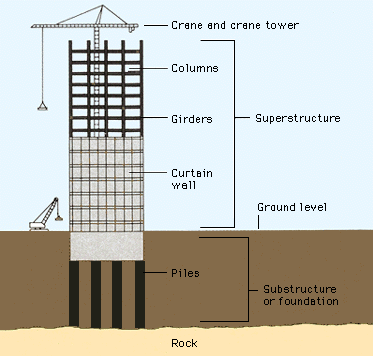Compounds of superstructure
Superstructure denotes parts of the of the structure lying above the surface of the ground. Various parts of walls, roof, doors, and windows, flooring, constitute the superstructure. The parts of the structure lying on the grounds and below the ground floor level are called the plinth.
The superstructure is designed to carry various load acting on the structure, such as dead load, live, load, wind load etc. which are then transmitted to the underlying soil via the substructure.
Each component of superstructure serves a specific purpose, however, the most common function served by all components is providing privacy, safety to the occupants. Wall and roof offer protection from the surrounding, doors allow entry and provide safety, windows provide necessary sunlight and fresh air and floor give a leveled surface to live and protection from beneath.
Building superstructure
Column: A column in structural engineering is a vertical structural element that transmits, through compression, the weight of the structure above to other structural elements below.
Floor: A floor typically consists of a support structure called a sub-floor on top of which is laid a floor cover into provides a walking surface.
Roof wall :
Flat – must have a slight slope for drainage
Shed – a single slope
Gable – two slopes meeting at a ridge. Two walls extend up to the ridge.
Hip – two gables, a pyramid could be considered a hip roof.
Gambrel – four slopes in one direction, the typical barn roof.
Mansard – two gambrels. Basically is to the gambrel what the hip is to gable.
Beam: Beam is rigid structural members designed to carry and transfer transverse loads across space to supporting elements.


